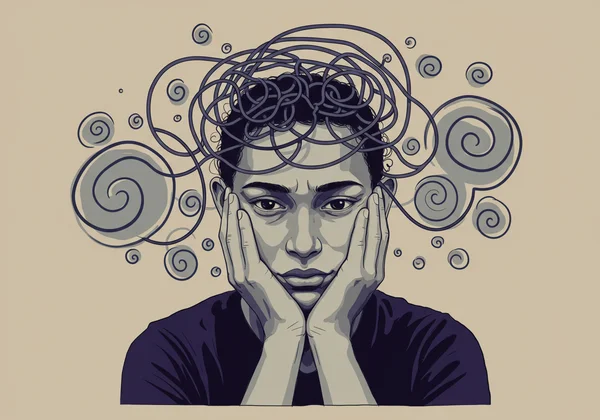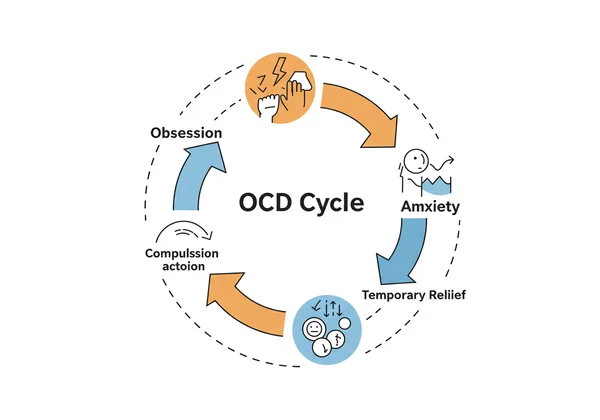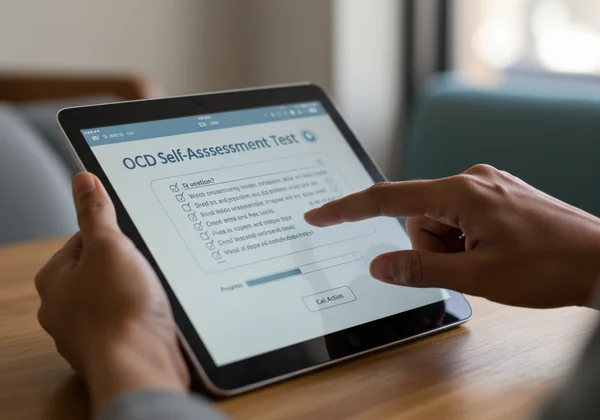Free OCD Test: 5 Ways to Manage Intrusive Thoughts & OCD Rumination
Are you constantly plagued by unwanted, repetitive thoughts that feel impossible to shake? Do you find yourself trapped in endless mental loops, questioning, analyzing, and re-analyzing? You're not alone. The challenge of managing intrusive thoughts is a difficult, often isolating experience. These mental patterns are hallmarks of conditions like Obsessive-Compulsive Disorder (OCD), causing significant distress and impacting daily life. But how to know if I have OCD? The first step is understanding these thoughts and learning that you can change your relationship with them.
This guide offers five actionable, science-backed techniques to help you gain a sense of control and create distance from these overwhelming thoughts. While these are not a cure, they are powerful "first-aid" skills to use alongside professional support. If these patterns resonate, an online OCD test can be a valuable first step. For a deeper, personalized understanding of your own patterns, you can start your self-assessment today.

Understanding Intrusive Thoughts & OCD Rumination: A Step Towards Your OCD Test
Before diving into coping skills, it's vital to understand what you're dealing with. Intrusive thoughts are unwanted thoughts, images, or urges that pop into your mind and can be disturbing or distressing. Rumination is the compulsive mental act of chewing on these thoughts, trying to solve, figure out, or neutralize them. Together, they create a powerful, exhausting cycle.
What Makes Intrusive Thoughts So Distressing?
Almost everyone experiences odd or unwanted thoughts. However, for individuals with OCD, these thoughts often feel sticky, significant, and deeply personal. They can be violent, sexual, or blasphemous in nature—the complete opposite of the person's true values. This clash is what makes them so terrifying; you worry the thought says something horrible about who you are. The distress isn't about the thought itself, but the meaning you assign to it.
The OCD Cycle: How Thoughts Become Traps
Understanding the OCD thought cycle is key to breaking free. It typically follows a pattern:
- Obsession: An intrusive thought, image, or urge appears and causes intense anxiety.
- Anxiety: You feel a surge of fear, guilt, or disgust. Your brain screams "DANGER!"
- Compulsion: To relieve the anxiety, you perform a mental or physical ritual. In the case of rumination, the compulsion is to mentally review, check, or seek reassurance about the thought.
- Temporary Relief: Completing the compulsion provides a fleeting sense of relief.
This relief reinforces the entire cycle, teaching your brain that the compulsion is the only way to feel safe. Over time, this trap becomes stronger and more automatic.

Practical OCD Coping Skills for Immediate Relief
The goal of these techniques isn't to eliminate intrusive thoughts—that's impossible. Instead, the goal is to change how you respond to them. By cutting off the compulsive response (like rumination), you break the cycle and teach your brain that these thoughts are not real threats.

Technique 1: Label and Let Go (Mindfulness-Based)
Mindfulness is the practice of observing your thoughts without judgment. When an intrusive thought arises, instead of getting caught up in its content, practice this simple, three-step process.
- Notice: Acknowledge that the thought has appeared.
- Label: Mentally label it with a neutral term. Say to yourself, "That's an intrusive thought," or "I'm having a thought about contamination," or even just "Thinking." This creates a small but crucial space between you and the thought.
- Let Go: Gently redirect your attention back to the present moment. Focus on your breath, the feeling of your feet on the floor, or the sounds around you. The thought may still be there, but your attention is elsewhere.
Technique 2: Defusion (Acceptance and Commitment Therapy)
Cognitive defusion techniques help you see thoughts for what they are: just words and images in your mind, not literal truths or commands. The goal is to "unhook" from them.
- Sing the Thought: Take your scary thought ("What if I harm someone?") and sing it to the tune of "Happy Birthday" or "Row, Row, Row Your Boat." It's hard to take a thought seriously when it sounds ridiculous.
- Use a Silly Voice: Imagine a cartoon character like Donald Duck or Bugs Bunny saying the thought out loud. This strips the thought of its emotional weight.
- Thank Your Mind: When a thought pops up, say, "Thanks, mind, for that interesting thought," and then carry on with your activity. This acknowledges the thought without engaging with it.
Technique 3: The "So What?" Response (Embracing Uncertainty)
OCD thrives on the need for 100% certainty. Resisting the urge to seek reassurance is a powerful way to fight back. When your mind presents a "what if" scenario, instead of arguing with it, respond with acceptance of the uncertainty.
- Intrusive Thought: "What if my hands aren't really clean?"
- Compulsive Urge: To re-wash them or mentally review how well you washed them.
- Uncertainty Response: "Maybe they are, maybe they aren't. I'm willing to sit with that uncertainty."
This feels terrifying at first, but by consistently choosing to accept doubt, you weaken OCD's power. It teaches your brain that you can handle not knowing for sure.
Technique 4: Time-Limited Worry/Rumination (Structured Engagement)
If you find it impossible to stop ruminating completely, try containing it. Schedule a specific, short period of time—say, 10 minutes every day at 5 PM—as your designated "worry time."
When an intrusive thought hits outside of this window, tell yourself, "I'll think about that during my scheduled worry time." Postpone the rumination. When your worry time arrives, you are allowed to think about the topic as much as you want for those 10 minutes. Often, you'll find that by the time the appointment arrives, the urge to ruminate has lessened or the thought seems less important. If you feel this pattern resonates with you, taking an OCD screening test can offer valuable initial insights.
Technique 5: Engage Your Senses & Body (Grounding)
Rumination is a purely mental activity. One of the quickest ways to interrupt it is to get out of your head and into your body. Grounding techniques anchor you in the present moment through your five senses.
Try the 5-4-3-2-1 method:
- 5: Acknowledge FIVE things you see around you.
- 4: Acknowledge FOUR things you can touch.
- 3: Acknowledge THREE things you can hear.
- 2: Acknowledge TWO things you can smell.
- 1: Acknowledge ONE thing you can taste.
This simple exercise shifts your focus away from the internal storm and onto the external world, providing an immediate break from the mental loop.
Taking the Next Step Towards Clarity & Control
Learning to manage intrusive thoughts is a journey, not a destination. These techniques are powerful tools to have in your arsenal, helping you reclaim your mental space and reduce your daily distress. They empower you to respond to your mind with intention rather than reacting out of fear.
However, these skills are often the first step. Understanding the specific nature and severity of your symptoms is crucial for finding the right path forward. If you recognize yourself in these cycles of thought and rumination, taking a free OCD test for clarity is essential. Our free, confidential OCD test, based on established scientific principles, can be a safe and reliable starting point. It provides a personalized analysis that can help you make sense of your experience.
Take our free OCD test now to gain a deeper understanding of your symptoms and take a confident first step towards professional support and lasting relief.

Frequently Asked Questions About Intrusive Thoughts & OCD
Is it normal to have intrusive thoughts?
Yes, virtually everyone experiences occasional intrusive thoughts. The key difference in OCD is the frequency, intensity, and the distressing meaning attached to them, which leads to compulsive behaviors (like rumination) to neutralize the anxiety.
How do I know if my intrusive thoughts are a sign of OCD?
The defining factor is whether the thoughts lead to compulsive behaviors that are time-consuming (e.g., more than an hour a day) and cause significant distress or impairment in your daily life. If you're unsure, an online tool can provide a preliminary look. We invite you to get a confidential analysis on our website.
Can intrusive thoughts from OCD be completely cured?
While there is no "cure" for OCD in the way you might cure an infection, it is highly treatable. With effective therapies like Exposure and Response Prevention (ERP), many people learn to manage their symptoms so effectively that they no longer significantly impact their lives. The thoughts may still pop up occasionally, but they no longer have power.
What is the most effective treatment for persistent intrusive thoughts & OCD symptoms?
The gold-standard treatment for OCD is a type of Cognitive Behavioral Therapy (CBT) called Exposure and Response Prevention (ERP), often combined with medication like SSRIs. ERP involves gradually confronting the thoughts and situations that trigger obsessions while resisting the urge to perform compulsions. A preliminary step like our OCD disorder test can be a helpful starting point to discuss with a professional.